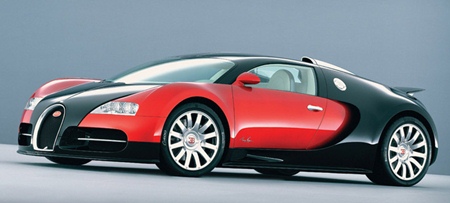Ettore Bugatti (Le Patron) decided at the start of the 1930’s that he should build the ‘ultimate’ car, even though he had made his name with small racing cars such as the Bugatti Type 35, incidentally the most successful racing car of all time with over 2,000 wins. But this was not enough for the eccentric Ettore Bugatti. He wished to be remembered for his Bugatti Royale, the Type 41.
The Royale was huge. The 13 liter engine was the most powerful ever installed in an automobile. It was fitted into a motor car more than 6.4 meters long. It sat on 38 inch wheels. Its radiator cap was a statue of a performing elephant, designed by his brother Rembrandt.
 Bugatti Veyron
Bugatti Veyron
However, it appeared in 1932, in time for the Great Depression and not even one royal family purchased a Royale. It remained an automotive anachronism of which only six or seven were built (nobody knows the exact number) and most remained unsold. The white elephant mascot was prophetic.
However, after the Bugatti firm went into liquidation, and having numerous successive owners, Volkswagen AG decided to revive the legendary Bugatti name, purchasing all trademark rights, and Bugatti Automobile S.A.S. was founded as a Volkswagen France subsidiary in Molsheim, Alsace, the town where the Royale was built. History was about to repeat itself.
In 2000, VW announced the Bugatti Veyron concept to the world; however, the first production model was not shown until the Tokyo Motor Show in 2005, to cost $1 million, develop 1,000 horsepower and attain 400 km/h.
The enormous W16 engine with its four turbochargers did indeed develop 1001 horsepower, but reaching the target speed of 400 km/h was not so easy. Aerodynamic instability was the problem. One prototype was destroyed in a crash and another spun out during a public demonstration at Monterey in America.
However, by May 2005, a prototype Veyron tested at a Volkswagen track near Wolfsburg, Germany, managed the magic 400 km/h (249 mph). In October, 2005, the final production version of the Veyron reached a top speed of 407.5 km/h (253.2 mph)! But the cost to build each car was far more than the one million USD ticket price. VW has had to sell each Veyron at a loss.
The Veyron in its final form is certainly not a French tour de force. The seven speed gearbox is made by Ricardo in the UK, and the unique 16 cylinder 8.0 litre engine comes from the Volkswagen engine plant in Salzgitter in Germany. The tyres – the first production tyres homologated for speeds above 400 km/h – are a joint development with Michelin. The carbon bre monocoque is built by ATR in Italy, the front and rear-structures in forged aluminium by Heggemann in Germany and the bespoke carbon-ceramic brakes by AP Racing in Great Britain. The paintwork is German, the leather Austrian, and the windscreen is manufactured in Finland. So much for its French heritage!
The end result is a vehicle which will reach 100 km/h in 2.5 seconds. It reaches 200 and 300 km/h in 7.4 and 16.7 seconds respectively. It gulps fuel at 125 liters per 100 km, and at full throttle empties its fuel tank in 12.5 minutes. Just as well, as the tyres will only last 15 minutes at top speed.
Max Born, the 1954 Nobel Prize winner in physics, said of space travel that it was “a triumph of intellect but a tragic failure of reason.” He could have been talking about the Bugatti Veyron. Certainly a triumph of engineering, but equally a failure of reason. It has no place in the automotive world. Today’s Bugatti Veyron is the reincarnation of the Bugatti Royale! All that is lacking is the white elephant mascot.




